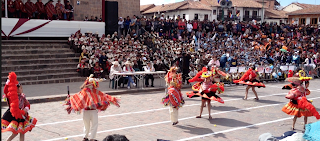I cannot believe Friday snuck up on me so fast, the last few days have been sort of a blur, but Cusco is still proving to be a great place to visit. Like Lima, the people here are very active. From the looks of the streets people must never stay in their homes too long. I am glad we are here during such an active season, even if it does mean many tourists are here as well. I was impressed with the parade of children dancing through the main plaza to andean music. I wish I knew more about the history of Peru so I could understand the many costumes different groups model. It is obvious through the detail that went into making these costumes that each group portrays an important part of peruvian/Incan history.
While walking around the Plaza de Armas yesterday, Dr. Brown pointed out the white stripe on what appeared to be a Quechuan flag. He asked the question of what the white stripe must mean considering the most common rainbow flag that we see consists of; red, orange, yellow, green, blue, indigo, and violet. This flag was the Inca Coat of Arms, and now serves symbolic significance for the indigenous people of the region. Many different variations of this flag have been used for different regions and the one with white stripe is the National Flag of Tawantinsuya. In this flag the colors are red, orange, yellow, white, green, blue, and purple. “The symbolism of the colors is red for earth, orange for society and culture, yellow for energy, white for time, green for economy, blue for space, and purple for policy” (Martins).
Above information can be found at: http://www.crwflags.com/fotw/flags/xi.html
Friday was a busy day starting at the Museo De Arte Precolombino. The museum was filled with almost a dozen different galleries displaying work from different ancient civilizations as well as galleries that concentrated on a particular discipline like wood or jewelry. One particular piece in the Nazca gallery that caught my eye was this vase pictured below. While we have seen many vases similar to this one, I have not concentrated on the ceramics of the Nazca to great extent. A common theme seen throughout peruvian cultures is step motif, and that is the first thing I notice when studying the top of this piece. This step pattern is repeated around the rim of the vase, and each staircase seems to be rotationally symmetric with its diagonal staircase. There is also a 2-1-2 pattern of an asterisk type symbol that continues around the vase. The asterisk symbols located near the middle of the vase are enclosed in three diamond shapes adding depth and emphasis to the symbol. Peru-facts.co.uk explains that Nazca pottery can be divided into three stages; early, classic, and later. It also mentions that early Nazca pottery was not colorful. While I could not make an assured assumption on when this piece was made, my guess would be that this piece was made during the late classic period, or later period due to the variety of colors that are used. (http://www.peru-facts.co.uk/nazca-lines-culture.html)




No comments:
Post a Comment